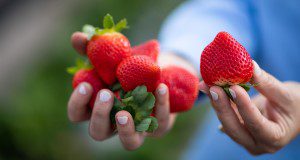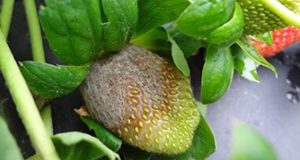Several different fungi and one bacterium cause leaf spot diseases of Florida strawberry. Symptoms caused by these pathogens are often similar, leading to confusion and misdiagnosis of the disease. To facilitate diagnosis, the most common leaf spots diseases of strawberry in Florida are described in this new 6-page article, written by Juliana S. Baggio, James C. Mertely, and Natalia A. Peres, and published by the UF/IFAS Plant Pathology Department.
https://edis.ifas.ufl.edu/pp359
Tag: James C. Mertely
Charcoal Rot of Strawberries Caused by Macrophomina phaseolina
Charcoal rot is caused by Macrophomina phaseolina and has become more prevalent in Florida strawberry fields since methyl bromide was phased out. This 4-page publication describes the symptoms, development, and control of charcoal rot in strawberry fields. Written by N. A. Peres, J. S. Baggio, and J. C. Mertely and published by the UF/IFAS Department of Plant Pathology, February 2018.
http://edis.ifas.ufl.edu/pp161
Botrytis Fruit Rot or Gray Mold of Strawberry
Botrytis fruit rot (BFR), also known as gray mold, is caused by the fungus Botrytis cinerea and is one of the most important diseases of strawberry in Florida and worldwide. This 4-page document describes the symptoms and management of BFR among strawberry plants. Written by J. C. Mertely, M. S. Oliveira, and N. A. Peres and published by the UF/IFAS Department of Plant Pathology, February 2018.
http://edis.ifas.ufl.edu/pp152
Powdery Mildew of Strawberries (PP208/PP129)
 Powdery mildew occurs in most areas of the world where strawberries are grown, infecting leaves, flowers, and fruit. Infected transplants are normally the primary source of inoculum for fruiting fields in Florida, but even disease-free fields can become infected by conidia blown in from neighboring fields. Fields with susceptible cultivars should be surveyed regularly for powdery mildew, especially early in the season. Usually, controlling foliar infection helps to prevent fruit infection. This 4-page fact sheet was written by N. A. Peres and J. C. Mertely, and published by the UF Department of Plant Pathology, May 2013.
Powdery mildew occurs in most areas of the world where strawberries are grown, infecting leaves, flowers, and fruit. Infected transplants are normally the primary source of inoculum for fruiting fields in Florida, but even disease-free fields can become infected by conidia blown in from neighboring fields. Fields with susceptible cultivars should be surveyed regularly for powdery mildew, especially early in the season. Usually, controlling foliar infection helps to prevent fruit infection. This 4-page fact sheet was written by N. A. Peres and J. C. Mertely, and published by the UF Department of Plant Pathology, May 2013.
http://edis.ifas.ufl.edu/pp129
Anthracnose Fruit Rot of Strawberry (PP207/PP130)
 Anthracnose fruit rot is an important disease for strawberry worldwide. Lesions appear as dark, sunken spots on infected fruit. This 4-page fact sheet was written by James C. Mertely and Natalia. A. Peres, and published by the UF Department of Plant Pathology, September 2012.
Anthracnose fruit rot is an important disease for strawberry worldwide. Lesions appear as dark, sunken spots on infected fruit. This 4-page fact sheet was written by James C. Mertely and Natalia. A. Peres, and published by the UF Department of Plant Pathology, September 2012.
http://edis.ifas.ufl.edu/pp130


